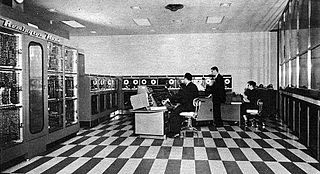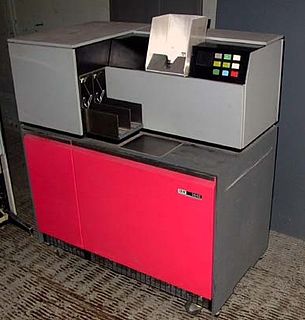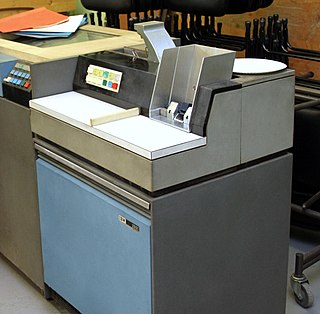
The IBM System/360 (S/360) is a family of mainframe computer systems that was announced by IBM on April 7, 1964, and delivered between 1965 and 1978. It was the first family of computers designed to cover both commercial and scientific applications and to cover a complete range of applications from small to large. The design distinguished between architecture and implementation, allowing IBM to release a suite of compatible designs at different prices. All but the only partially compatible Model 44 and the most expensive systems use microcode to implement the instruction set, which features 8-bit byte addressing and binary, decimal, and hexadecimal floating-point calculations.

The IBM 1620 was announced by IBM on October 21, 1959, and marketed as an inexpensive scientific computer. After a total production of about two thousand machines, it was withdrawn on November 19, 1970. Modified versions of the 1620 were used as the CPU of the IBM 1710 and IBM 1720 Industrial Process Control Systems.

UNIVAC was a line of electronic digital stored-program computers starting with the products of the Eckert–Mauchly Computer Corporation. Later the name was applied to a division of the Remington Rand company and successor organizations.

IBM 1442 is a combination IBM card reader and card punch. It reads and punches 80-column IBM-format punched cards and is used on the IBM 1440, the IBM 1130, the IBM 1800 and System/360 and is an option on the IBM System/3.

Starting at the end of the nineteenth century, well before the advent of electronic computers, data processing was performed using electromechanical machines collectively referred to as unit record equipment, electric accounting machines (EAM) or tabulating machines. Unit record machines came to be as ubiquitous in industry and government in the first two-thirds of the twentieth century as computers became in the last third. They allowed large volume, sophisticated data-processing tasks to be accomplished before electronic computers were invented and while they were still in their infancy. This data processing was accomplished by processing punched cards through various unit record machines in a carefully choreographed progression. This progression, or flow, from machine to machine was often planned and documented with detailed flowcharts that used standardized symbols for documents and the various machine functions. All but the earliest machines had high-speed mechanical feeders to process cards at rates from around 100 to 2,000 per minute, sensing punched holes with mechanical, electrical, or, later, optical sensors. The operation of many machines was directed by the use of a removable plugboard, control panel, or connection box. Initially all machines were manual or electromechanical. The first use of an electronic component was in 1937 when a photocell was used in a Social Security bill-feed machine. Electronic components were used on other machines beginning in the late 1940s.

A keypunch is a device for precisely punching holes into stiff paper cards at specific locations as determined by keys struck by a human operator. Other devices included here for that same function include the gang punch, the pantograph punch, and the stamp. The term was also used for similar machines used by humans to transcribe data onto punched tape media.

The IBM System/3 was an IBM midrange computer introduced in 1969, and marketed until 1985. It was produced by IBM Rochester in Minnesota as a low-end business computer aimed at smaller organizations that still used IBM 1400 series computers or unit record equipment. The first member of what IBM refers to as their "midrange" line, it also introduced the RPG II programming language. It is the first ancestor in the product line whose current version is the IBM i series and includes the highly successful AS/400.

IBM manufactured and sold document processing equipment such as proof machines, inscribers and document reader/sorters for financial institutions from 1934 to 2005.

From the invention of computer programming languages up to the mid-1970s, most computer programmers created, edited and stored their programs line by line on punch cards.

The IBM 2540 is a punched-card computer peripheral manufactured by IBM Corporation for use of System/360 and later computer systems. The 2540 was designed by IBM's Data Processing Division in Rochester, Minnesota, and was introduced in 1965. The 2540 can read punched-cards at 1000 cards per minute (CPM) and punch at 300 CPM. The 2540 is based on the design of the older, slightly slower, 1402.
The IBM 2780 and the IBM 3780 are devices developed by IBM to perform remote job entry (RJE) and other batch functions over telephone lines; they communicate with the mainframe via Binary Synchronous Communications and replaced older terminals using synchronous transmit-receive (STR). In addition, IBM has developed workstation programs for the 1130, 360/20, 2922, System/360 other than 360/20, System/370 and System/3.

The IBM 1402 was a high speed card reader/punch introduced on October 5, 1959 as a peripheral input/output device for the IBM 1401 computer. It was later used with other computers of the IBM 1400 series and IBM 7000 series product lines. It was adapted as the IBM 1622 Card Read-Punch for the IBM 1620 and provided the basic design for the models 2501, 2520 and 2540 equipment used with the IBM System/360 product line.

A computer punched card reader or just computer card reader is a computer input device used to read computer programs in either source or executable form and data from punched cards. A computer card punch is a computer output device that punches holes in cards. Sometimes computer punch card readers were combined with computer card punches and, later, other devices to form multifunction machines. It is a input device and also an output device. Most early computers, such as the ENIAC, and the IBM NORC, provided for punched card input/output. Card readers and punches, either connected to computers or in off-line card to/from magnetic tape configurations, were ubiquitous through the mid-1970s.

The IBM 2821 Control Unit attaches card readers and card punches, and line printers to the IBM System/360 and IBM System/370 families of computers. The devices attached may be a combination of:

The IBM System/360 Model 20 is the smallest member of the IBM System/360 family announced in November 1964. The Model 20 supports only a subset of the System/360 instruction set, with binary numbers limited to 16 bits and no floating point. In later years it would have been classified as a 16-bit minicomputer rather than a mainframe, but the term "minicomputer" was not current, and in any case IBM wanted to emphasize the compatibility of the Model 20 rather than its differences from the rest of the System/360 line. It does, however, have the full System/360 decimal instruction set, that allows for addition, subtraction, product, and dividend of up to 31 decimal digits.
The IBM 2922 Programmable Terminal is a Remote Job Entry (RJE) terminal introduced by IBM in 1972. The 2922 communicated using Binary Synchronous Communications (Bisync).

The IBM 2501 is a punched-card reader from IBM with models for the System/360 and System/370 mainframe systems and for the IBM System/360 Model 20, the IBM 1130 and IBM System/3 minicomputers. 2501 models can read 80-column cards at either 600 or 1000 cards per minute (CPM).

The IBM System/360 Model 25 is a low-end member of the IBM System/360 family. It was announced on January 3, 1968, 3 years before the IBM System/360 Model 22, as a "bridge between its old and new computing systems".

IBM designed, manufactured and sold optical mark and character readers from 1960 until 1984. The IBM 1287 is notable as being the first commercially sold scanner capable of reading handwritten numbers.

















